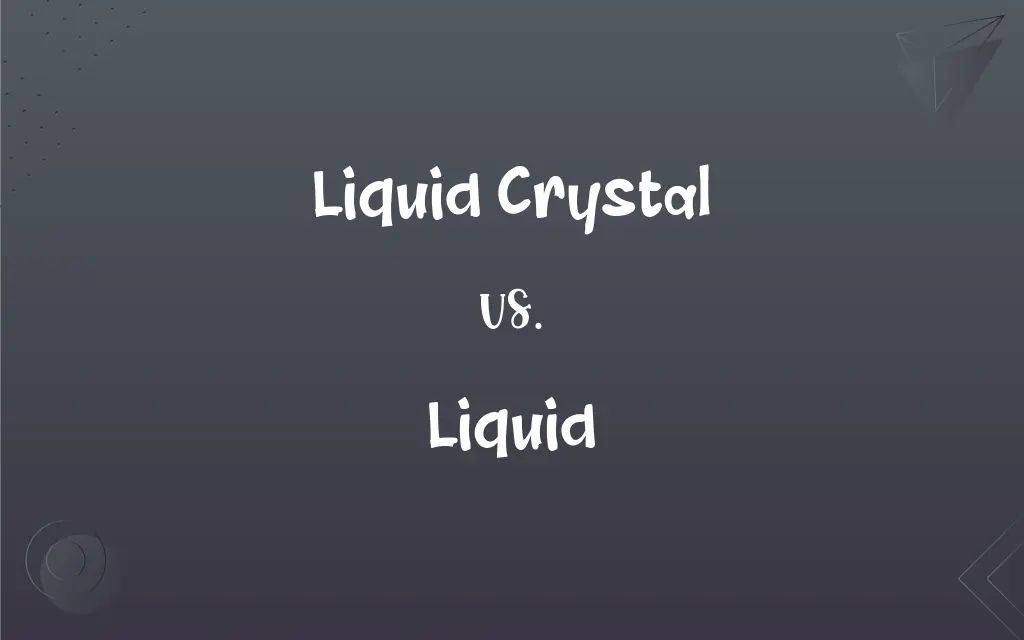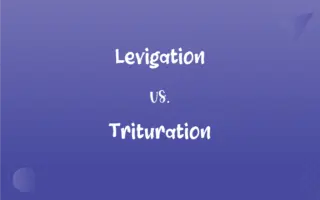Liquid Crystal vs. Liquid: What's the Difference?
Edited by Aimie Carlson || By Janet White || Published on February 22, 2024
Liquid crystal is a substance that flows like a liquid but maintains some ordered structure like a solid, while a liquid has no fixed shape and flows freely.

Key Differences
Liquid crystals exist in a state that combines properties of both liquids and solid crystals. Their molecules are more ordered than in a typical liquid, allowing them to flow while maintaining structure. Regular liquids, however, have molecules that move freely and do not exhibit any long-range order.
In liquid crystals, molecules are often elongated and maintain a certain alignment, which is pivotal in technologies like LCD screens. In contrast, the molecules in a liquid are randomly oriented and move independently, which is why liquids take the shape of their container and have a uniform appearance.
The unique molecular arrangement of liquid crystals allows them to react predictably to electric fields, making them useful in digital displays. Liquids, due to their lack of molecular order, do not exhibit such responsiveness to electric fields and are used in a variety of applications based on their flow properties.
Liquid crystals can transition to different phases (e.g., nematic, smectic) under varying temperatures, displaying distinct optical properties. Standard liquids do not exhibit such phase behavior and maintain consistent optical properties unless they change state (e.g., freezing or boiling).
The application of liquid crystals extends to thermometers, displays, and other electronic devices due to their unique molecular behavior. Liquids are more diverse in their applications, used in everything from hydraulics to beverages, due to their fluid nature and ability to dissolve substances.
ADVERTISEMENT
Comparison Chart
Molecular Order
Partially ordered, with aligned molecules.
Molecules move freely, no fixed order.
Flow Properties
Flows like a liquid but maintains structure.
Flows freely, takes shape of container.
Response to Electric Fields
Responsive, used in electronic displays.
Not responsive in the same way.
Phase Behavior
Exhibits distinct phases with temperature.
Consistent properties unless state changes.
Applications
Used in screens, thermometers, electronics.
Wide range, including beverages, hydraulics.
ADVERTISEMENT
Liquid Crystal and Liquid Definitions
Liquid Crystal
Material used in LCDs due to its unique electrical properties.
The smartphone's screen is made of advanced liquid crystal.
Liquid
A state of matter with no fixed shape but a fixed volume.
The mercury in the thermometer was in a liquid state.
Liquid Crystal
Used in various electronic and optical applications.
The liquid crystal in the projector created sharp images.
Liquid
Can be transformed into gas or solid under certain conditions.
The liquid froze into ice in the freezer.
Liquid Crystal
A state of matter that flows like a liquid but has molecular order.
The liquid crystal display on his watch was clear and bright.
Liquid
A fluid substance that conforms to the shape of its container.
Water is the most common liquid we use daily.
Liquid Crystal
Responsive to temperature and electric fields.
The liquid crystal thermometer changed color with the temperature.
Liquid
Characterized by free-flowing molecules.
Oil, as a liquid, is used for lubrication in machines.
Liquid Crystal
Exhibits properties between solid crystals and liquids.
Liquid crystal technology has revolutionized digital displays.
Liquid
Used widely in various industries for different applications.
The factory used a special liquid for cooling processes.
Liquid
The state of matter in which a substance exhibits a characteristic readiness to flow and little or no tendency to disperse, and is amorphous but has a fixed volume and is difficult to compress.
FAQs
Where are liquid crystals commonly used?
Liquid crystals are most commonly used in displays of electronic devices, like watches, calculators, and TVs.
How do liquid crystals work in displays?
In displays, liquid crystals modulate light passage based on electrical stimuli, enabling image formation.
Can liquid crystals exist naturally?
Yes, some liquid crystals occur naturally, such as in biological membranes and certain plants.
Are there different types of liquid crystals?
Yes, there are several types, including nematic, smectic, and cholesteric, each with distinct molecular arrangements.
How are liquid crystal displays (LCDs) energy efficient?
LCDs are energy efficient because they use a backlight rather than emitting light directly, reducing power consumption.
Do liquid crystals change color?
Some liquid crystals can change color in response to temperature or other stimuli, useful in sensors and thermometers.
Can liquids compress?
Liquids are minimally compressible due to close molecular arrangement but more so than solids.
What is a liquid crystal?
A liquid crystal is a state of matter that has properties between those of conventional liquids and solid crystals.
What advancements are being made in liquid crystal technology?
Advancements include improved display technologies, tunable lenses, and applications in photonics and biotechnology.
What makes liquid crystals align in a particular way?
Liquid crystals align due to molecular shape and external influences like electric fields or temperature.
Can liquid crystals revert to a normal liquid?
Yes, when heated beyond a certain point, liquid crystals can revert to a standard liquid state.
What is surface tension in liquids?
Surface tension is the cohesive force at a liquid’s surface, making it contract and resist external forces.
What causes a liquid to flow?
Liquids flow due to weaker intermolecular forces compared to solids, allowing molecules to move past each other.
What is capillary action in liquids?
Capillary action is the ability of a liquid to flow in narrow spaces without assistance, often against gravity.
What determines a liquid's viscosity?
A liquid's viscosity, or resistance to flow, is determined by its molecular composition and temperature.
Are all liquids transparent?
Not all liquids are transparent. Opacity in liquids can result from suspended particles, molecular composition, or colorants.
What defines a substance as a liquid?
A liquid is a state of matter with a definite volume but no fixed shape, adapting to the container shape.
How does pressure affect the boiling point of liquids?
Higher pressure generally increases a liquid's boiling point, and lower pressure decreases it.
How does temperature affect a liquid?
Increasing temperature generally decreases liquid viscosity, making it flow more easily.
How do liquids differ from gases?
Liquids have a definite volume unlike gases, and are denser due to closer molecular spacing.
About Author
Written by
Janet WhiteJanet White has been an esteemed writer and blogger for Difference Wiki. Holding a Master's degree in Science and Medical Journalism from the prestigious Boston University, she has consistently demonstrated her expertise and passion for her field. When she's not immersed in her work, Janet relishes her time exercising, delving into a good book, and cherishing moments with friends and family.
Edited by
Aimie CarlsonAimie Carlson, holding a master's degree in English literature, is a fervent English language enthusiast. She lends her writing talents to Difference Wiki, a prominent website that specializes in comparisons, offering readers insightful analyses that both captivate and inform.





































































